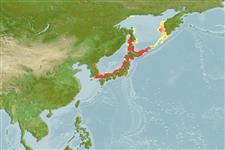Preferred temperature (Ref.
123201): 0.3 - 16.5, mean 3.3 °C (based on 86 cells).
Phylogenetic diversity index (Ref.
82804): PD
50 = 0.5000 [Uniqueness, from 0.5 = low to 2.0 = high].
Bayesian length-weight: a=0.00955 (0.00605 - 0.01506), b=3.03 (2.90 - 3.16), in cm total length, based on LWR estimates for this species & Genus-body shape (Ref.
93245).
Nível Trófico (Ref.
69278): 3.6 ±0.59 se; based on food items.
Resiliência (Ref.
120179): Médio, tempo mínimo de duplicação da população 1,4 - 4,4 anos (tm=4; tmax=6; Fec=1,000).
Fishing Vulnerability (Ref.
59153): Moderate to high vulnerability (52 of 100).
🛈
Climate Vulnerability (Ref.
125649): Moderate to high vulnerability (49 of 100).
🛈
Nutrients (Ref.
124155): Calcium = 14.3 [4.9, 37.9] mg/100g; Iron = 0.265 [0.131, 0.597] mg/100g; Protein = 18.2 [17.0, 19.3] %; Omega3 = 1.64 [0.75, 3.60] g/100g; Selenium = 98.8 [29.8, 308.1] μg/100g; VitaminA = 14.2 [4.6, 42.8] μg/100g; Zinc = 0.545 [0.335, 1.074] mg/100g (wet weight);
